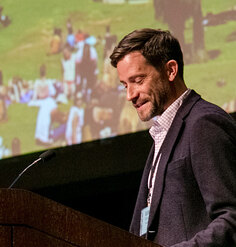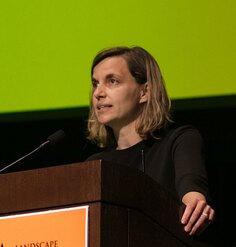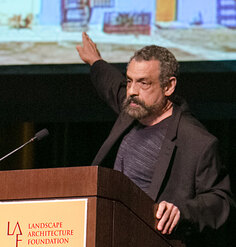The Art of Survival
By Kongjian Yu
This presentation was part of the Landscape Architecture Foundation’s The New Landscape Declaration: A Summit on Landscape Architecture and the Future held in Philadelphia on June 10-11, 2016. LAF asked a diverse group of leading minds to write a “Declaration” reflecting on the last half century and offering bold ideas for how landscape architecture can make its vital contribution in response to the challenges of our time.
Kongjian Yu
Dean, Peking College of Architecture and Landscape
Beijing, China
Kongjian Yu, D.Des., is founder and dean of Peking University College of Architecture and Landscape. He founded Tunescape, the first private firm of its kind in China, and practices globally. He received his doctor of design from Harvard Graduate School of Design.
* Affiliation at the time of the Summit
The Art of Survival
by Kongjian Yu
The past 50 years have been fruitful for the profession of landscape architecture. Compared to the environmental situation that our ecological planning pioneers faced 50 years ago, North American and European countries, where urbanization and industrialization had led other parts of the world, have seen great improvement. The profession of landscape architecture has been key to these improvements by raising public awareness and improving the practice of planning and designing our natural and human ecosystems. In addition, we have learned to manage our natural and cultural assets better using a variety of techniques, such as design with nature, sustainable site management, ecological stormwater management, greenways and green infrastructure, green roofs, and community engagement. Such obvious success has proved what had been projected by our forerunners 50 years ago in the 1966 Declaration of Concern: “There is no one-shot cure, nor single-purpose panacea, but the need for collaborative solutions.”
But the challenge to survival is not yet over. The improvements at the limited regional scale in the United States cannot remediate the deteriorating global situation. Today, along with globalization and worldwide urbanization, what had been regional and national environmental issues 50 years ago are now global and are particularly troublesome in developing areas such as China, India, and Southeast Asia. Moreover, the severity of the changes, such as increasing water, food, and energy shortages, coupled with environmental degradation, threaten the survival of humanity itself. In China, for example, within the past 50 years, the population has doubled, the population in urban areas has increased six-fold, 75 percent of the surface water is polluted, and 400 cities suffer water shortages. At the same time, 70 percent of the population struggles with urban and rural flooding every year, one-third of the nation is under threat of heavy smog, 50 percent of wetlands have disappeared in the past 50 years, and a significant number of rare species will never be seen again. In addition, China has suffered a significant loss of much of its rich cultural heritage. The leaders of the profession said half a century ago that “what is merely offensive or disturbing today threatens life itself tomorrow,” and it is clear that we have no place to escape.
We are, however, not helpless. What our pioneers have done in North America since the 1966 declaration proves to the world that the charge launched by the profession of landscape architecture against environmental degradation is successful, and an integrative and symbiotic approach, namely, the design of landscape processes and patterns, is the key. What we need to sustain us in the next charge against global environmental degradation is to replicate what has proved successful in best practices, opening up ever more integrative and symbiotic approaches at even larger scales and working even more comprehensively. More than at any other time in history, we must fulfill the mission of healing the earth, a mission defined by our forefathers, where the landscape architect should be a “conductor,” as Ian McHarg declared, not a solo artist, who can bring all related disciplines and individuals into the medium of landscape.
To face such global challenges and opportunities, we have come to the point of redefining the profession of landscape architecture as the art of survival: to heal the earth and sustain humanity. Landscape is the medium where all natural, biological, and cultural processes interact, and landscape architecture (the planning, design, and management of the landscape) is, therefore, the profession that could take the lead in meeting the challenges of survival in a complicated physical and cultural environment.
In facing contemporary ecological and environmental issues, three strategies will allow our profession to take leadership. First is planning practice. We must secure and consolidate across scales an integrated ecological infrastructure that safeguards various ecological and cultural assets and provides effective multiple ecosystem services, which will be the tool and framework for smart growth and smart preservation.
Second, design and management practice. We need to define a new aesthetic, the “big feet” aesthetic (the aesthetics of sustainability), as opposed to the distorted “little feet” aesthetics of ornamental, calling for deep forms (as opposed to the costly shallow or fake forms) with human desires based on healthy ecological processes; this aesthetic must be high performance and productive, able to provide critical ecosystems services with little maintenance.
And third, global cooperation and education. As professionals and academics, we must cooperate at the global scale, sharing knowledge and working together in a real battle against environmental challenges at any corner of this globe. We know that any change in one part of the globe will affect us in another part; we must reform and restructure the education programs of landscape architecture to build and consolidate the bedrock of landscape architecture as an art of survival, through building and sharing the wisdom of survival skills and techniques in dealing with floods, drought, and food production, instead of teaching the ornamental art of gardening and pleasure-making of an elite culture. Let peasantry and sustainable vernacular landscape practices show students the knowledge and windows for survival in various climate and environment situations, and let them build a database to share among professionals the best practices for facing various environmental challenges. These will open up a wholly new horizon for the profession of landscape architecture.











